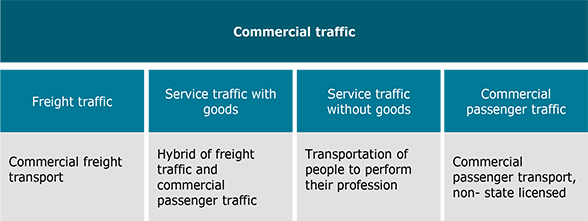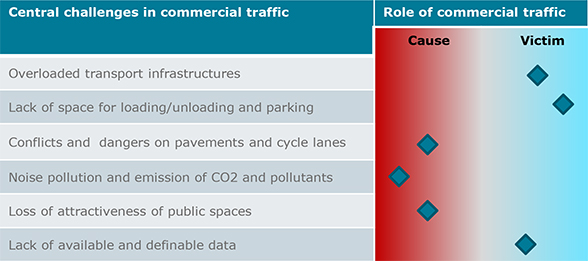Commercial traffic is essential to a functioning economy and a prosperous society. The Swiss population benefits from this every day: shop shelves are well stocked with our favourite goods, waste is regularly disposed of, and packages ordered online are delivered to our homes. The same traffic also places a burden on the transport system, society and the environment. However, little research has been done on what actually constitutes commercial traffic, which is why there is little discussion on how to deal with it in Switzerland.
Framework study on commercial traffic: Promote dialogue and coordination between the public and private sectors
The framework study drawn up by the Federal Office for Spatial Development (ARE) in cooperation with the federal offices responsible for roads (FEDRO), transport (FOT), energy (SFOE) and the environment (FOEN) looks at the impact of commercial traffic. It provides an important basis for clarifying the Confederation's role in dealing with urban commercial traffic.
Among other things, the study shows the need for dialogue and coordination between the public sector at all three levels of government and with the business community. Going forward, the Confederation intends to use the instruments and resources at its disposal to promote the proper functioning of commercial traffic, e.g. in the 4th generation of the agglomeration programme on transport and built-up areas (not available in English).
Definition and segmentation of commercial
traffic
Commercial traffic refers to the movement of goods and persons for commercial and professional purposes. This primarily means supply and disposal services for trade, commerce and industry, and the public sector.
Traffic for business purposes includes all journeys made under the responsibility of private undertakings. Traffic for professional purposes includes all journeys made under the responsibility of public institutions. Thus, commercial traffic covers both private and public sector journeys. However, the journey must have a business or professional purpose. Commuting to and from workplaces is not covered by this definition.
Commercial traffic comprises the four segments goods traffic, passenger traffic and services traffic with and without goods (see Figure 1). The segments are not defined by the vehicles used, but primarily by the purpose. Around 16.5 per cent of all road traffic today is commercial traffic.

Challenges for urban commercial traffic
Commercial traffic is often perceived to be a hindrance. Managing it has until now been a low priority among the general public and politicians, even though it plays such a key role in the economy and society. However, this type of traffic also places a burden on the transport system, society and the environment. We therefore need to take a more precise look at the challenges involved, in order to respond appropriately (see Figure 2).

Documents
Commercial traffic in urban areas (PDF, 9 MB, 01.11.2021)German (Abstract in English)
Media
Contact
Federal Office for Spatial Development ARE
Franziska Borer Blindenbacher
3003 Bern
+41 58 46 25576

